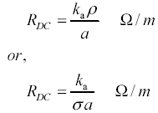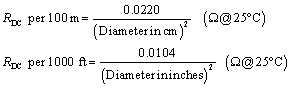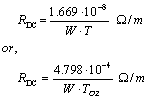DC Resistance
Practical transmission lines [13] incorporate series resistance. The nonzero resistance of practical transmission lines dissipates a portion of the signal power, causing both attenuation (loss) and distortion in propagating signals. This section shows how to estimate the DC resistance (per meter) of a transmission line.
[13] Thin-film superconducting transmission lines have essentially no series resistance provided that you keep them cold. For high-speed digital applications the requirement for cold-temperature operation renders them, in this author's opinion, not practical.
Equation 2.37

|
where |
a is the cross-sectional area of the conductor (m 2 ), |
|
k a is a correction factor that accounts for the additional DC resistance of the return path , |
|
|
r is the resistivity of the conductor ( W “m), or |
|
|
s is the conductivity of the conductor (S/m). |
For annealed copper at room temperature r = 1.724 ·10 “8 W “m and s = 5.800 ·10 7 S/m.
Note that the effective DC resistance of a transmission-line structure is the sum of the DC resistance of the signal conductor plus the DC resistance of the return path. In [2.37] the factor 1/ s a accounts only for the resistance of the signal conductor. The factor k a accounts for the additional resistance of the return path. The factor k a equals a quotient , the numerator of which is the sum of the DC resistances of the signal and return paths, and the denominator of which is the DC resistance of the signal path alone.
For example, a pcb trace with a wide, flat return path has K a = 1, because the resistance of the wide, flat return path is so low it adds almost nothing to the overall DC resistance of the structure.
A twisted-pair configuration, because the outbound (signal) and return (~signal) wires are the same, has K a = 2.
A coaxial cable has a DC resistance equal to the sum of the resistances of the center conductor and shield. In many cases the center conductor may be composed of plated or clad materials. The shield often incorporates a braided construction with or without an inner foil wrap. When working with coaxial cables it's usually best to just accept the worst-case specification provided by the manufacturer for R DC and not try to compute it.
The series resistance for long cables is often specified in ohms per 1,000 feet or ohms per 100 meters . When dealing with twisted-pair cables, the specified resistance usually includes the series resistance of both the outgoing and return wires. For coaxial cables the manufacturer often separately specifies the series resistances of the center conductor and outer shield. In any calculations of signal loss you must always add the resistance of both outgoing and return pathways , because current flows equally in both, and both dissipate power.
Here are eight rules of thumb for estimating the DC resistance of round copper wires:
- The American Wire Gauge (AWG) system is a logarithmic measure of the diameter of round wires. The larger the gauge, the smaller the wire.
- Six AWG points halves the diameter.
- Area being proportional to diameter-squared, three AWG points halves the cross-sectional area.
- Three AWG points doubles the wire resistance.
- A round conductor of size #24 American Wire Gauge (24-AWG) has a nominal diameter of 0.507 mm (0.02 in.) and a resistance at room temperature of 0.085 W /m (26 W /1000 ft).
- Twisted-pair 24-AWG cable has a total series resistance (adding both wires in series) of 0.170 W /m (52 W /1000 ft) at room temperature.
- RG-58/U coaxial cable using a stranded core of AWG 20 has a resistance at room temperature of 0.034 W /m (10.3 W /1000 ft).
- The resistance of copper increases 0.39% with every 1 °C increase in temperature. Over a 70 °C temperature range, that amounts to a variation of 31%.
Here are some handy equations for working with AWG sizes:
Equation 2.38

Equation 2.39

Equation 2.40

The resistance (per unit length) of a printed-circuit trace varies with copper thickness and trace width. The trace thickness is rated in plating weight, typically reported in ounces. A 1-oz plating corresponds to a thickness of 34.8 m m. The thickness scales in proportion to plating weight. [14] The resistance of an electrodeposited pure copper pcb trace may be calculated from its thickness and width.
[14] Plating weight in units of ounces refers to the number of ounces of material deposited on a flat surface one foot square.
Equation 2.41

|
where |
R DC s the series resistance of the line ( W /m), |
|
W is the width of line (m), |
|
|
T is the thickness of line (m), which equals 3.48 ·10 “5 meters (1.37 mil) for one ounce of plating weight, or |
|
|
T OZ is the plating weight of the line in ounces (oz/ft 2 ). |
A 1/2-oz copper pcb trace with 100- m m (4-mil) width has a DC resistance of 9.6 W /m.
POINT TO REMEMBER
- The nonzero resistance of practical transmission lines dissipates a portion of the signal power, causing both attenuation (loss) and distortion in propagating signals.
Fundamentals
- Impedance of Linear, Time-Invariant, Lumped-Element Circuits
- Power Ratios
- Rules of Scaling
- The Concept of Resonance
- Extra for Experts: Maximal Linear System Response to a Digital Input
Transmission Line Parameters
- Transmission Line Parameters
- Telegraphers Equations
- Derivation of Telegraphers Equations
- Ideal Transmission Line
- DC Resistance
- DC Conductance
- Skin Effect
- Skin-Effect Inductance
- Modeling Internal Impedance
- Concentric-Ring Skin-Effect Model
- Proximity Effect
- Surface Roughness
- Dielectric Effects
- Impedance in Series with the Return Path
- Slow-Wave Mode On-Chip
Performance Regions
- Performance Regions
- Signal Propagation Model
- Hierarchy of Regions
- Necessary Mathematics: Input Impedance and Transfer Function
- Lumped-Element Region
- RC Region
- LC Region (Constant-Loss Region)
- Skin-Effect Region
- Dielectric Loss Region
- Waveguide Dispersion Region
- Summary of Breakpoints Between Regions
- Equivalence Principle for Transmission Media
- Scaling Copper Transmission Media
- Scaling Multimode Fiber-Optic Cables
- Linear Equalization: Long Backplane Trace Example
- Adaptive Equalization: Accelerant Networks Transceiver
Frequency-Domain Modeling
- Frequency-Domain Modeling
- Going Nonlinear
- Approximations to the Fourier Transform
- Discrete Time Mapping
- Other Limitations of the FFT
- Normalizing the Output of an FFT Routine
- Useful Fourier Transform-Pairs
- Effect of Inadequate Sampling Rate
- Implementation of Frequency-Domain Simulation
- Embellishments
- Checking the Output of Your FFT Routine
Pcb (printed-circuit board) Traces
- Pcb (printed-circuit board) Traces
- Pcb Signal Propagation
- Limits to Attainable Distance
- Pcb Noise and Interference
- Pcb Connectors
- Modeling Vias
- The Future of On-Chip Interconnections
Differential Signaling
- Differential Signaling
- Single-Ended Circuits
- Two-Wire Circuits
- Differential Signaling
- Differential and Common-Mode Voltages and Currents
- Differential and Common-Mode Velocity
- Common-Mode Balance
- Common-Mode Range
- Differential to Common-Mode Conversion
- Differential Impedance
- Pcb Configurations
- Pcb Applications
- Intercabinet Applications
- LVDS Signaling
Generic Building-Cabling Standards
- Generic Building-Cabling Standards
- Generic Cabling Architecture
- SNR Budgeting
- Glossary of Cabling Terms
- Preferred Cable Combinations
- FAQ: Building-Cabling Practices
- Crossover Wiring
- Plenum-Rated Cables
- Laying Cables in an Uncooled Attic Space
- FAQ: Older Cable Types
100-Ohm Balanced Twisted-Pair Cabling
- 100-Ohm Balanced Twisted-Pair Cabling
- UTP Signal Propagation
- UTP Transmission Example: 10BASE-T
- UTP Noise and Interference
- UTP Connectors
- Issues with Screening
- Category-3 UTP at Elevated Temperature
150-Ohm STP-A Cabling
- 150-Ohm STP-A Cabling
- 150- W STP-A Signal Propagation
- 150- W STP-A Noise and Interference
- 150- W STP-A: Skew
- 150- W STP-A: Radiation and Safety
- 150- W STP-A: Comparison with UTP
- 150- W STP-A Connectors
Coaxial Cabling
- Coaxial Cabling
- Coaxial Signal Propagation
- Coaxial Cable Noise and Interference
- Coaxial Cable Connectors
Fiber-Optic Cabling
- Fiber-Optic Cabling
- Making Glass Fiber
- Finished Core Specifications
- Cabling the Fiber
- Wavelengths of Operation
- Multimode Glass Fiber-Optic Cabling
- Single-Mode Fiber-Optic Cabling
Clock Distribution
- Clock Distribution
- Extra Fries, Please
- Arithmetic of Clock Skew
- Clock Repeaters
- Stripline vs. Microstrip Delay
- Importance of Terminating Clock Lines
- Effect of Clock Receiver Thresholds
- Effect of Split Termination
- Intentional Delay Adjustments
- Driving Multiple Loads with Source Termination
- Daisy-Chain Clock Distribution
- The Jitters
- Power Supply Filtering for Clock Sources, Repeaters, and PLL Circuits
- Intentional Clock Modulation
- Reduced-Voltage Signaling
- Controlling Crosstalk on Clock Lines
- Reducing Emissions
Time-Domain Simulation Tools and Methods
- Ringing in a New Era
- Signal Integrity Simulation Process
- The Underlying Simulation Engine
- IBIS (I/O Buffer Information Specification)
- IBIS: History and Future Direction
- IBIS: Issues with Interpolation
- IBIS: Issues with SSO Noise
- Nature of EMC Work
- Power and Ground Resonance
Points to Remember
Appendix A. Building a Signal Integrity Department
Appendix B. Calculation of Loss Slope
Appendix C. Two-Port Analysis
- Appendix C. Two-Port Analysis
- Simple Cases Involving Transmission Lines
- Fully Configured Transmission Line
- Complicated Configurations
Appendix D. Accuracy of Pi Model
Appendix E. erf( )
Notes
EAN: N/A
Pages: 163
- MPLS Operation
- Basic MPLS Configuration
- Configuring L2TPv3 Dynamic Tunnels
- L2 VPN-Any to Any Interworking
- Case Study 2: Implementing Multi-VRF CE, VRF Selection Using Source IP Address, VRF Selection Using Policy-Based Routing, NAT and HSRP Support in MPLS VPN, and Multicast VPN Support over Multi-VRF CE
